Strategic Initiatives for Global Growth: Entry Modes and Alliances
VerifiedAdded on 2021/04/17
|13
|3091
|48
Essay
AI Summary
This essay provides a comprehensive analysis of strategic initiatives for global growth, focusing on the importance of market analysis, the scale and timing of entry, and the various entry modes available to companies seeking international expansion. It examines criteria used by firms for international growth, emphasizing the significance of market size, economic growth, and consumer wealth. The essay explores different entry modes such as direct exporting, franchising, joint ventures, direct investment, acquisitions, and contract manufacturing, evaluating their advantages and disadvantages. It also links the choice of entry modes to Porter's Five Forces model, highlighting the importance of analyzing competitive forces. The essay further discusses the benefits and challenges of strategic alliances, providing real-world examples and models like Hollensen’s and Johnson’s to illustrate key concepts. Finally, it emphasizes the importance of choosing the right entry mode based on the company's specific needs and the characteristics of the target market, with the goal of achieving sustainable global growth and competitive advantage.
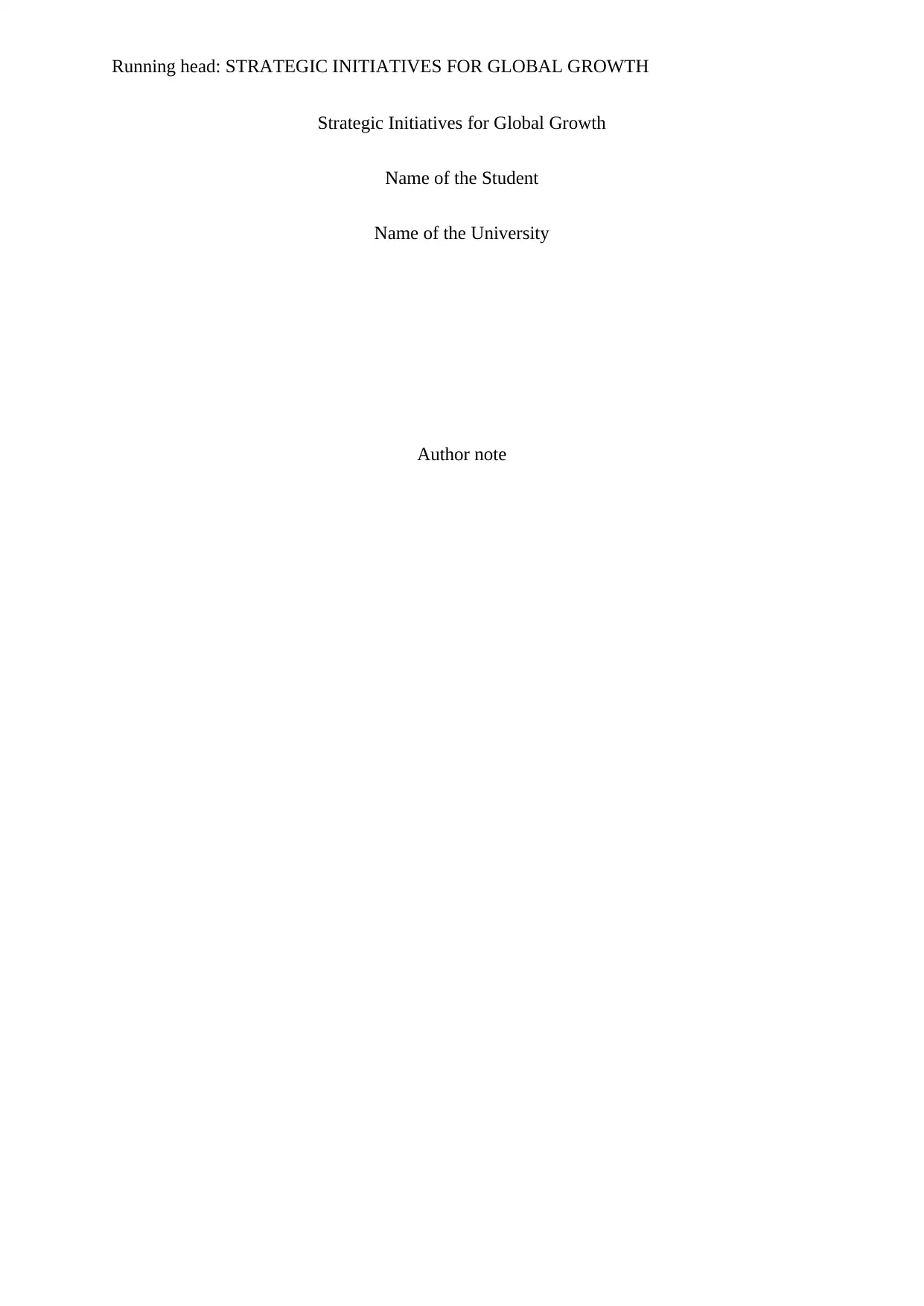
Running head: STRATEGIC INITIATIVES FOR GLOBAL GROWTH
Strategic Initiatives for Global Growth
Name of the Student
Name of the University
Author note
Strategic Initiatives for Global Growth
Name of the Student
Name of the University
Author note
Paraphrase This Document
Need a fresh take? Get an instant paraphrase of this document with our AI Paraphraser
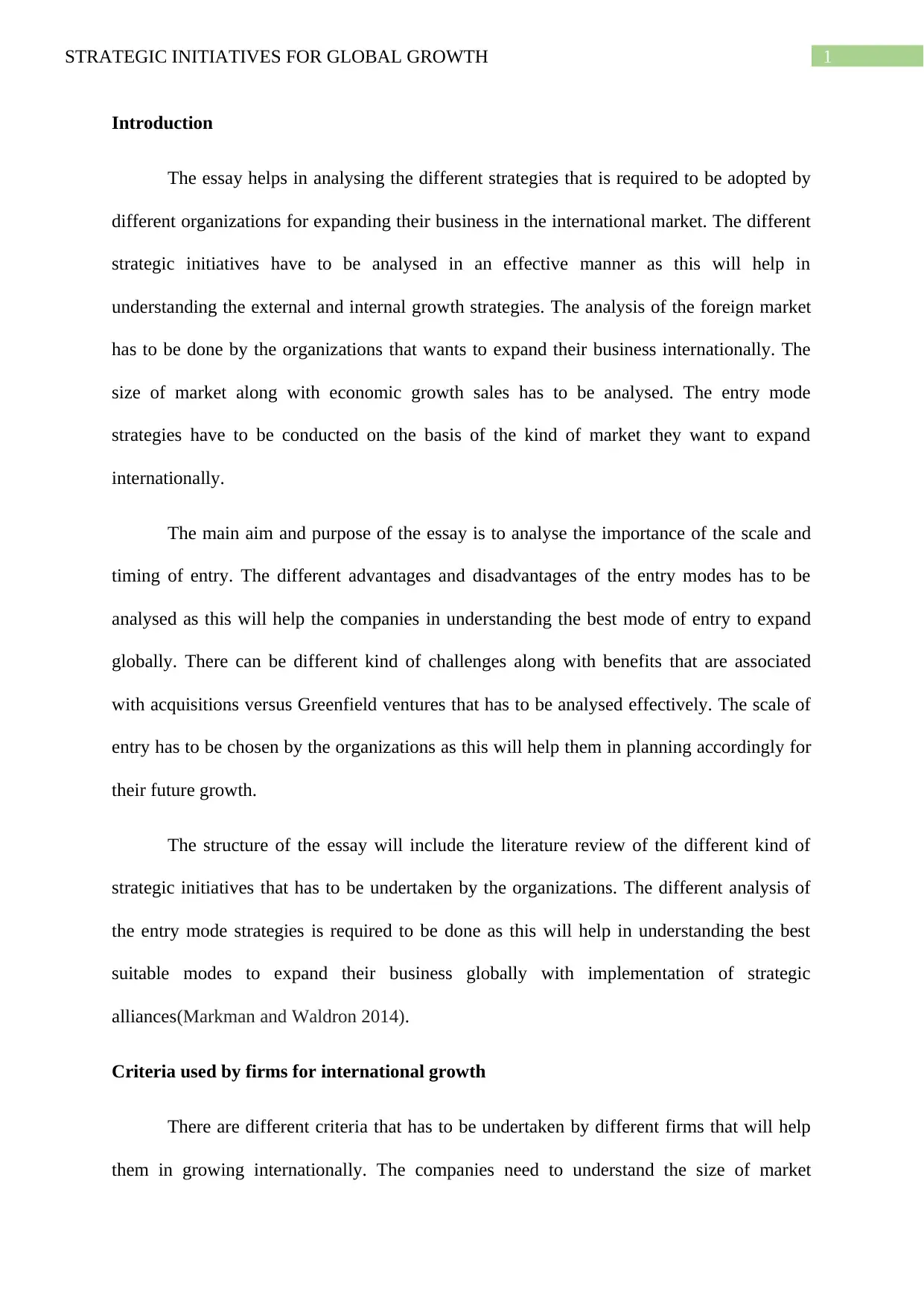
1STRATEGIC INITIATIVES FOR GLOBAL GROWTH
Introduction
The essay helps in analysing the different strategies that is required to be adopted by
different organizations for expanding their business in the international market. The different
strategic initiatives have to be analysed in an effective manner as this will help in
understanding the external and internal growth strategies. The analysis of the foreign market
has to be done by the organizations that wants to expand their business internationally. The
size of market along with economic growth sales has to be analysed. The entry mode
strategies have to be conducted on the basis of the kind of market they want to expand
internationally.
The main aim and purpose of the essay is to analyse the importance of the scale and
timing of entry. The different advantages and disadvantages of the entry modes has to be
analysed as this will help the companies in understanding the best mode of entry to expand
globally. There can be different kind of challenges along with benefits that are associated
with acquisitions versus Greenfield ventures that has to be analysed effectively. The scale of
entry has to be chosen by the organizations as this will help them in planning accordingly for
their future growth.
The structure of the essay will include the literature review of the different kind of
strategic initiatives that has to be undertaken by the organizations. The different analysis of
the entry mode strategies is required to be done as this will help in understanding the best
suitable modes to expand their business globally with implementation of strategic
alliances(Markman and Waldron 2014).
Criteria used by firms for international growth
There are different criteria that has to be undertaken by different firms that will help
them in growing internationally. The companies need to understand the size of market
Introduction
The essay helps in analysing the different strategies that is required to be adopted by
different organizations for expanding their business in the international market. The different
strategic initiatives have to be analysed in an effective manner as this will help in
understanding the external and internal growth strategies. The analysis of the foreign market
has to be done by the organizations that wants to expand their business internationally. The
size of market along with economic growth sales has to be analysed. The entry mode
strategies have to be conducted on the basis of the kind of market they want to expand
internationally.
The main aim and purpose of the essay is to analyse the importance of the scale and
timing of entry. The different advantages and disadvantages of the entry modes has to be
analysed as this will help the companies in understanding the best mode of entry to expand
globally. There can be different kind of challenges along with benefits that are associated
with acquisitions versus Greenfield ventures that has to be analysed effectively. The scale of
entry has to be chosen by the organizations as this will help them in planning accordingly for
their future growth.
The structure of the essay will include the literature review of the different kind of
strategic initiatives that has to be undertaken by the organizations. The different analysis of
the entry mode strategies is required to be done as this will help in understanding the best
suitable modes to expand their business globally with implementation of strategic
alliances(Markman and Waldron 2014).
Criteria used by firms for international growth
There are different criteria that has to be undertaken by different firms that will help
them in growing internationally. The companies need to understand the size of market
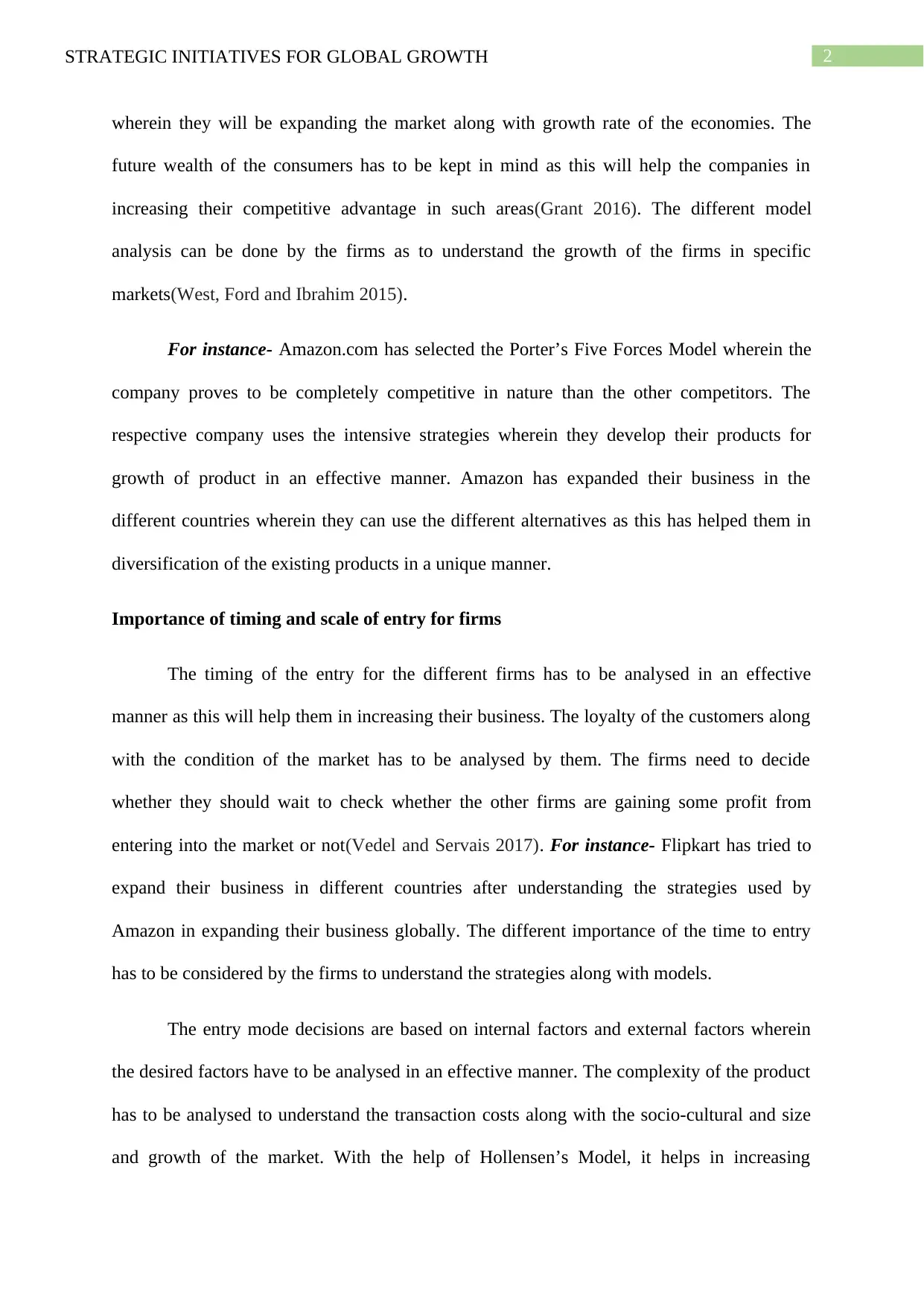
2STRATEGIC INITIATIVES FOR GLOBAL GROWTH
wherein they will be expanding the market along with growth rate of the economies. The
future wealth of the consumers has to be kept in mind as this will help the companies in
increasing their competitive advantage in such areas(Grant 2016). The different model
analysis can be done by the firms as to understand the growth of the firms in specific
markets(West, Ford and Ibrahim 2015).
For instance- Amazon.com has selected the Porter’s Five Forces Model wherein the
company proves to be completely competitive in nature than the other competitors. The
respective company uses the intensive strategies wherein they develop their products for
growth of product in an effective manner. Amazon has expanded their business in the
different countries wherein they can use the different alternatives as this has helped them in
diversification of the existing products in a unique manner.
Importance of timing and scale of entry for firms
The timing of the entry for the different firms has to be analysed in an effective
manner as this will help them in increasing their business. The loyalty of the customers along
with the condition of the market has to be analysed by them. The firms need to decide
whether they should wait to check whether the other firms are gaining some profit from
entering into the market or not(Vedel and Servais 2017). For instance- Flipkart has tried to
expand their business in different countries after understanding the strategies used by
Amazon in expanding their business globally. The different importance of the time to entry
has to be considered by the firms to understand the strategies along with models.
The entry mode decisions are based on internal factors and external factors wherein
the desired factors have to be analysed in an effective manner. The complexity of the product
has to be analysed to understand the transaction costs along with the socio-cultural and size
and growth of the market. With the help of Hollensen’s Model, it helps in increasing
wherein they will be expanding the market along with growth rate of the economies. The
future wealth of the consumers has to be kept in mind as this will help the companies in
increasing their competitive advantage in such areas(Grant 2016). The different model
analysis can be done by the firms as to understand the growth of the firms in specific
markets(West, Ford and Ibrahim 2015).
For instance- Amazon.com has selected the Porter’s Five Forces Model wherein the
company proves to be completely competitive in nature than the other competitors. The
respective company uses the intensive strategies wherein they develop their products for
growth of product in an effective manner. Amazon has expanded their business in the
different countries wherein they can use the different alternatives as this has helped them in
diversification of the existing products in a unique manner.
Importance of timing and scale of entry for firms
The timing of the entry for the different firms has to be analysed in an effective
manner as this will help them in increasing their business. The loyalty of the customers along
with the condition of the market has to be analysed by them. The firms need to decide
whether they should wait to check whether the other firms are gaining some profit from
entering into the market or not(Vedel and Servais 2017). For instance- Flipkart has tried to
expand their business in different countries after understanding the strategies used by
Amazon in expanding their business globally. The different importance of the time to entry
has to be considered by the firms to understand the strategies along with models.
The entry mode decisions are based on internal factors and external factors wherein
the desired factors have to be analysed in an effective manner. The complexity of the product
has to be analysed to understand the transaction costs along with the socio-cultural and size
and growth of the market. With the help of Hollensen’s Model, it helps in increasing
⊘ This is a preview!⊘
Do you want full access?
Subscribe today to unlock all pages.

Trusted by 1+ million students worldwide
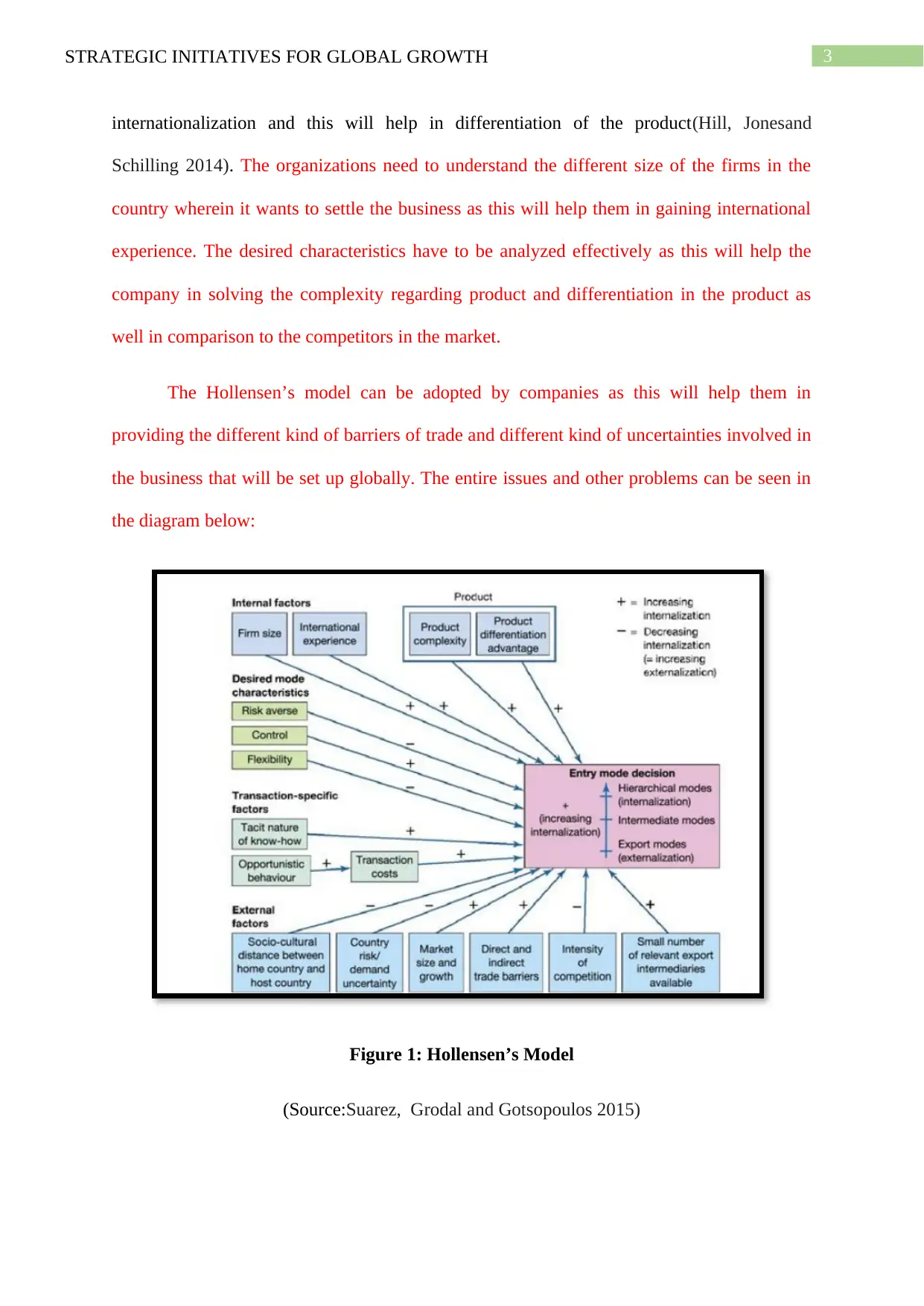
3STRATEGIC INITIATIVES FOR GLOBAL GROWTH
internationalization and this will help in differentiation of the product(Hill, Jonesand
Schilling 2014). The organizations need to understand the different size of the firms in the
country wherein it wants to settle the business as this will help them in gaining international
experience. The desired characteristics have to be analyzed effectively as this will help the
company in solving the complexity regarding product and differentiation in the product as
well in comparison to the competitors in the market.
The Hollensen’s model can be adopted by companies as this will help them in
providing the different kind of barriers of trade and different kind of uncertainties involved in
the business that will be set up globally. The entire issues and other problems can be seen in
the diagram below:
Figure 1: Hollensen’s Model
(Source:Suarez, Grodal and Gotsopoulos 2015)
internationalization and this will help in differentiation of the product(Hill, Jonesand
Schilling 2014). The organizations need to understand the different size of the firms in the
country wherein it wants to settle the business as this will help them in gaining international
experience. The desired characteristics have to be analyzed effectively as this will help the
company in solving the complexity regarding product and differentiation in the product as
well in comparison to the competitors in the market.
The Hollensen’s model can be adopted by companies as this will help them in
providing the different kind of barriers of trade and different kind of uncertainties involved in
the business that will be set up globally. The entire issues and other problems can be seen in
the diagram below:
Figure 1: Hollensen’s Model
(Source:Suarez, Grodal and Gotsopoulos 2015)
Paraphrase This Document
Need a fresh take? Get an instant paraphrase of this document with our AI Paraphraser
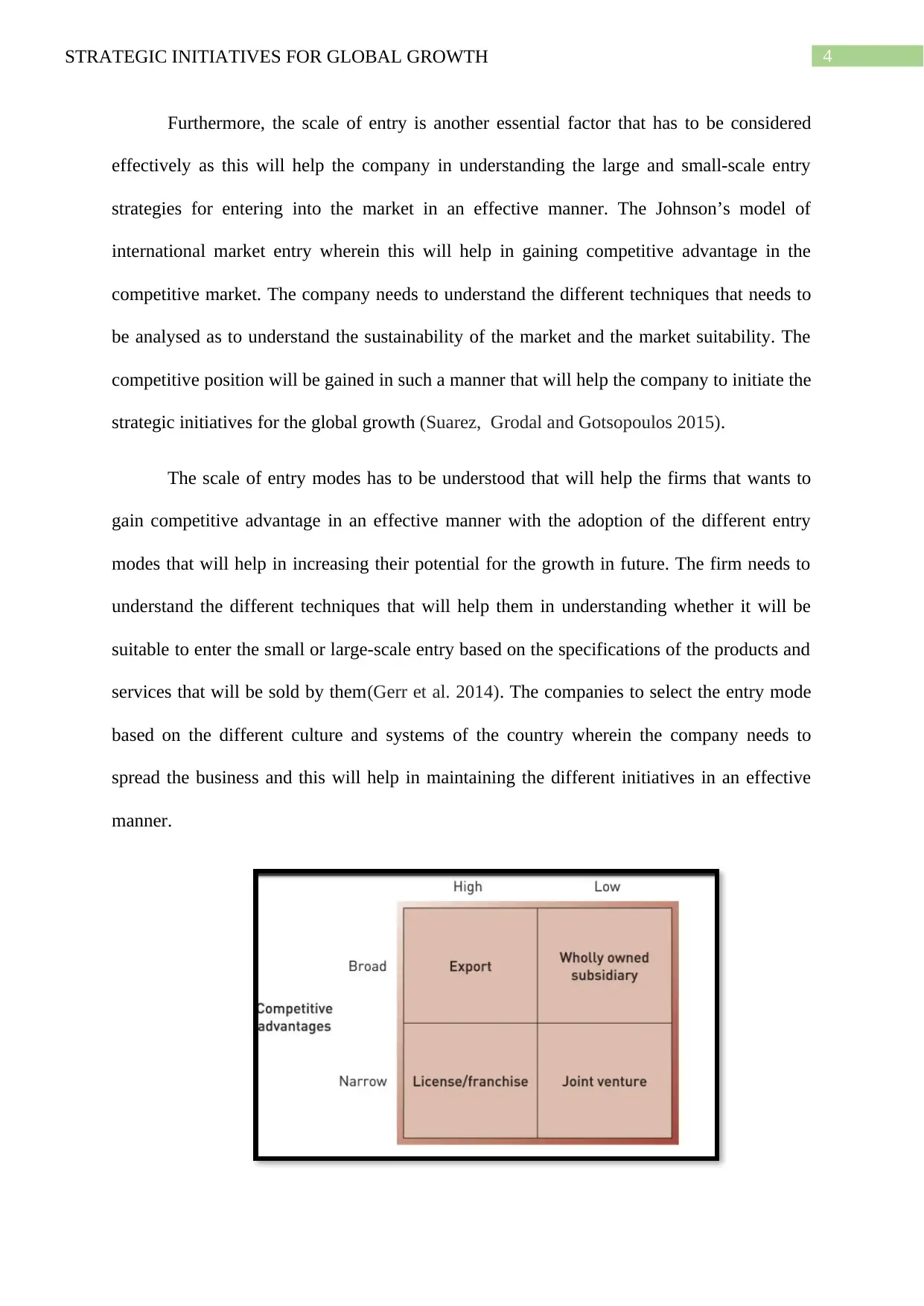
4STRATEGIC INITIATIVES FOR GLOBAL GROWTH
Furthermore, the scale of entry is another essential factor that has to be considered
effectively as this will help the company in understanding the large and small-scale entry
strategies for entering into the market in an effective manner. The Johnson’s model of
international market entry wherein this will help in gaining competitive advantage in the
competitive market. The company needs to understand the different techniques that needs to
be analysed as to understand the sustainability of the market and the market suitability. The
competitive position will be gained in such a manner that will help the company to initiate the
strategic initiatives for the global growth (Suarez, Grodal and Gotsopoulos 2015).
The scale of entry modes has to be understood that will help the firms that wants to
gain competitive advantage in an effective manner with the adoption of the different entry
modes that will help in increasing their potential for the growth in future. The firm needs to
understand the different techniques that will help them in understanding whether it will be
suitable to enter the small or large-scale entry based on the specifications of the products and
services that will be sold by them(Gerr et al. 2014). The companies to select the entry mode
based on the different culture and systems of the country wherein the company needs to
spread the business and this will help in maintaining the different initiatives in an effective
manner.
Furthermore, the scale of entry is another essential factor that has to be considered
effectively as this will help the company in understanding the large and small-scale entry
strategies for entering into the market in an effective manner. The Johnson’s model of
international market entry wherein this will help in gaining competitive advantage in the
competitive market. The company needs to understand the different techniques that needs to
be analysed as to understand the sustainability of the market and the market suitability. The
competitive position will be gained in such a manner that will help the company to initiate the
strategic initiatives for the global growth (Suarez, Grodal and Gotsopoulos 2015).
The scale of entry modes has to be understood that will help the firms that wants to
gain competitive advantage in an effective manner with the adoption of the different entry
modes that will help in increasing their potential for the growth in future. The firm needs to
understand the different techniques that will help them in understanding whether it will be
suitable to enter the small or large-scale entry based on the specifications of the products and
services that will be sold by them(Gerr et al. 2014). The companies to select the entry mode
based on the different culture and systems of the country wherein the company needs to
spread the business and this will help in maintaining the different initiatives in an effective
manner.
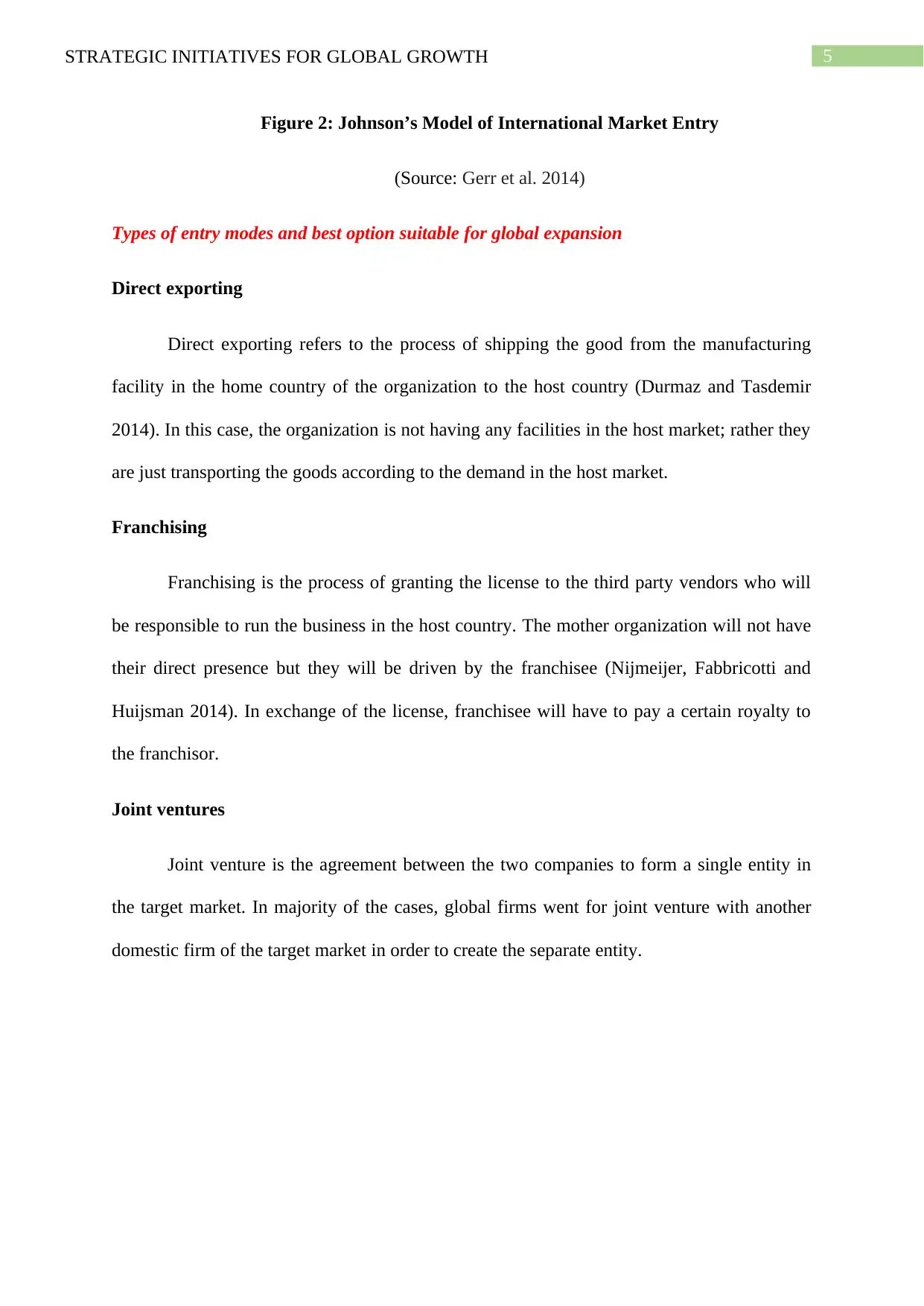
5STRATEGIC INITIATIVES FOR GLOBAL GROWTH
Figure 2: Johnson’s Model of International Market Entry
(Source: Gerr et al. 2014)
Types of entry modes and best option suitable for global expansion
Direct exporting
Direct exporting refers to the process of shipping the good from the manufacturing
facility in the home country of the organization to the host country (Durmaz and Tasdemir
2014). In this case, the organization is not having any facilities in the host market; rather they
are just transporting the goods according to the demand in the host market.
Franchising
Franchising is the process of granting the license to the third party vendors who will
be responsible to run the business in the host country. The mother organization will not have
their direct presence but they will be driven by the franchisee (Nijmeijer, Fabbricotti and
Huijsman 2014). In exchange of the license, franchisee will have to pay a certain royalty to
the franchisor.
Joint ventures
Joint venture is the agreement between the two companies to form a single entity in
the target market. In majority of the cases, global firms went for joint venture with another
domestic firm of the target market in order to create the separate entity.
Figure 2: Johnson’s Model of International Market Entry
(Source: Gerr et al. 2014)
Types of entry modes and best option suitable for global expansion
Direct exporting
Direct exporting refers to the process of shipping the good from the manufacturing
facility in the home country of the organization to the host country (Durmaz and Tasdemir
2014). In this case, the organization is not having any facilities in the host market; rather they
are just transporting the goods according to the demand in the host market.
Franchising
Franchising is the process of granting the license to the third party vendors who will
be responsible to run the business in the host country. The mother organization will not have
their direct presence but they will be driven by the franchisee (Nijmeijer, Fabbricotti and
Huijsman 2014). In exchange of the license, franchisee will have to pay a certain royalty to
the franchisor.
Joint ventures
Joint venture is the agreement between the two companies to form a single entity in
the target market. In majority of the cases, global firms went for joint venture with another
domestic firm of the target market in order to create the separate entity.
⊘ This is a preview!⊘
Do you want full access?
Subscribe today to unlock all pages.

Trusted by 1+ million students worldwide
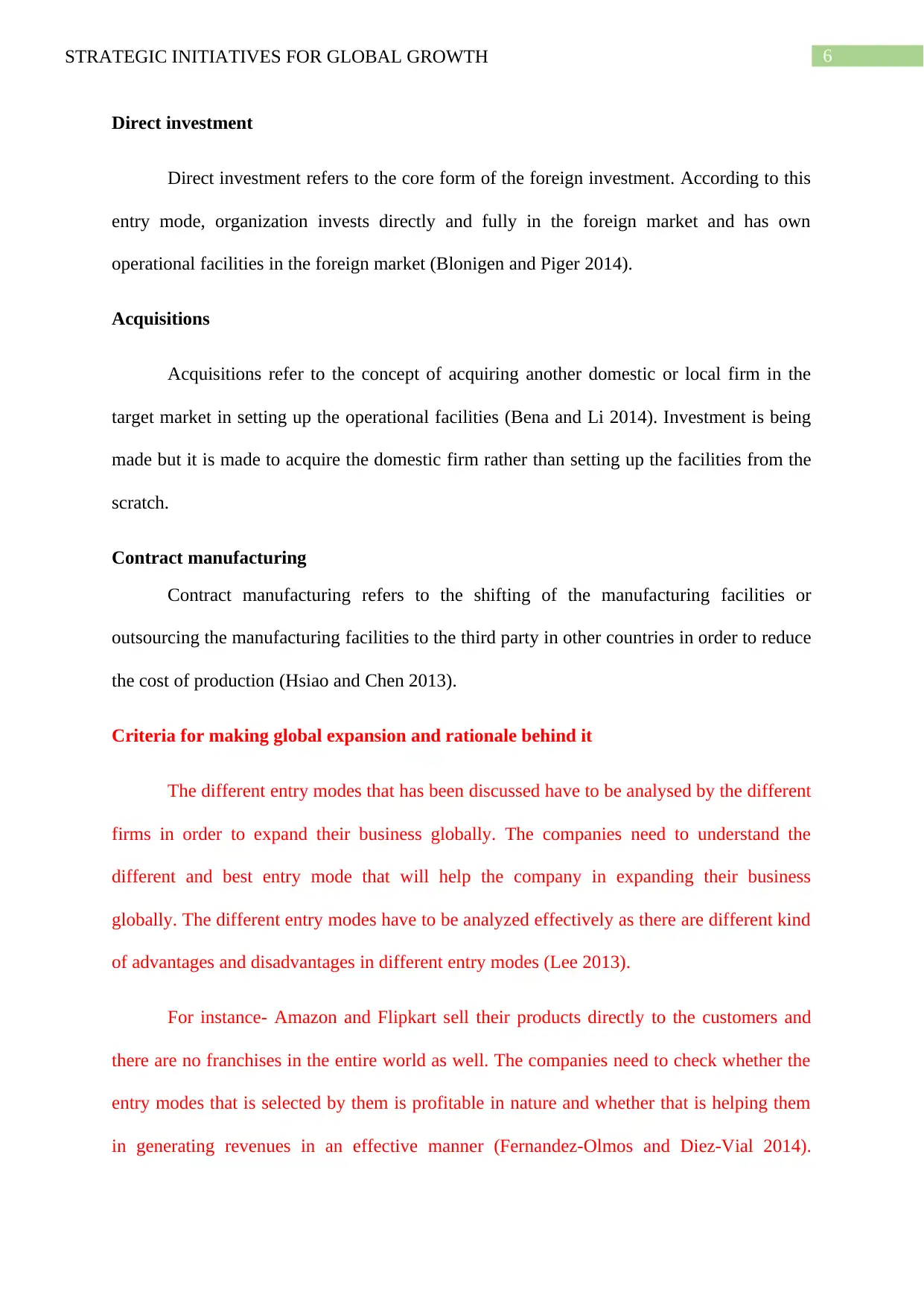
6STRATEGIC INITIATIVES FOR GLOBAL GROWTH
Direct investment
Direct investment refers to the core form of the foreign investment. According to this
entry mode, organization invests directly and fully in the foreign market and has own
operational facilities in the foreign market (Blonigen and Piger 2014).
Acquisitions
Acquisitions refer to the concept of acquiring another domestic or local firm in the
target market in setting up the operational facilities (Bena and Li 2014). Investment is being
made but it is made to acquire the domestic firm rather than setting up the facilities from the
scratch.
Contract manufacturing
Contract manufacturing refers to the shifting of the manufacturing facilities or
outsourcing the manufacturing facilities to the third party in other countries in order to reduce
the cost of production (Hsiao and Chen 2013).
Criteria for making global expansion and rationale behind it
The different entry modes that has been discussed have to be analysed by the different
firms in order to expand their business globally. The companies need to understand the
different and best entry mode that will help the company in expanding their business
globally. The different entry modes have to be analyzed effectively as there are different kind
of advantages and disadvantages in different entry modes (Lee 2013).
For instance- Amazon and Flipkart sell their products directly to the customers and
there are no franchises in the entire world as well. The companies need to check whether the
entry modes that is selected by them is profitable in nature and whether that is helping them
in generating revenues in an effective manner (Fernandez-Olmos and Diez-Vial 2014).
Direct investment
Direct investment refers to the core form of the foreign investment. According to this
entry mode, organization invests directly and fully in the foreign market and has own
operational facilities in the foreign market (Blonigen and Piger 2014).
Acquisitions
Acquisitions refer to the concept of acquiring another domestic or local firm in the
target market in setting up the operational facilities (Bena and Li 2014). Investment is being
made but it is made to acquire the domestic firm rather than setting up the facilities from the
scratch.
Contract manufacturing
Contract manufacturing refers to the shifting of the manufacturing facilities or
outsourcing the manufacturing facilities to the third party in other countries in order to reduce
the cost of production (Hsiao and Chen 2013).
Criteria for making global expansion and rationale behind it
The different entry modes that has been discussed have to be analysed by the different
firms in order to expand their business globally. The companies need to understand the
different and best entry mode that will help the company in expanding their business
globally. The different entry modes have to be analyzed effectively as there are different kind
of advantages and disadvantages in different entry modes (Lee 2013).
For instance- Amazon and Flipkart sell their products directly to the customers and
there are no franchises in the entire world as well. The companies need to check whether the
entry modes that is selected by them is profitable in nature and whether that is helping them
in generating revenues in an effective manner (Fernandez-Olmos and Diez-Vial 2014).
Paraphrase This Document
Need a fresh take? Get an instant paraphrase of this document with our AI Paraphraser
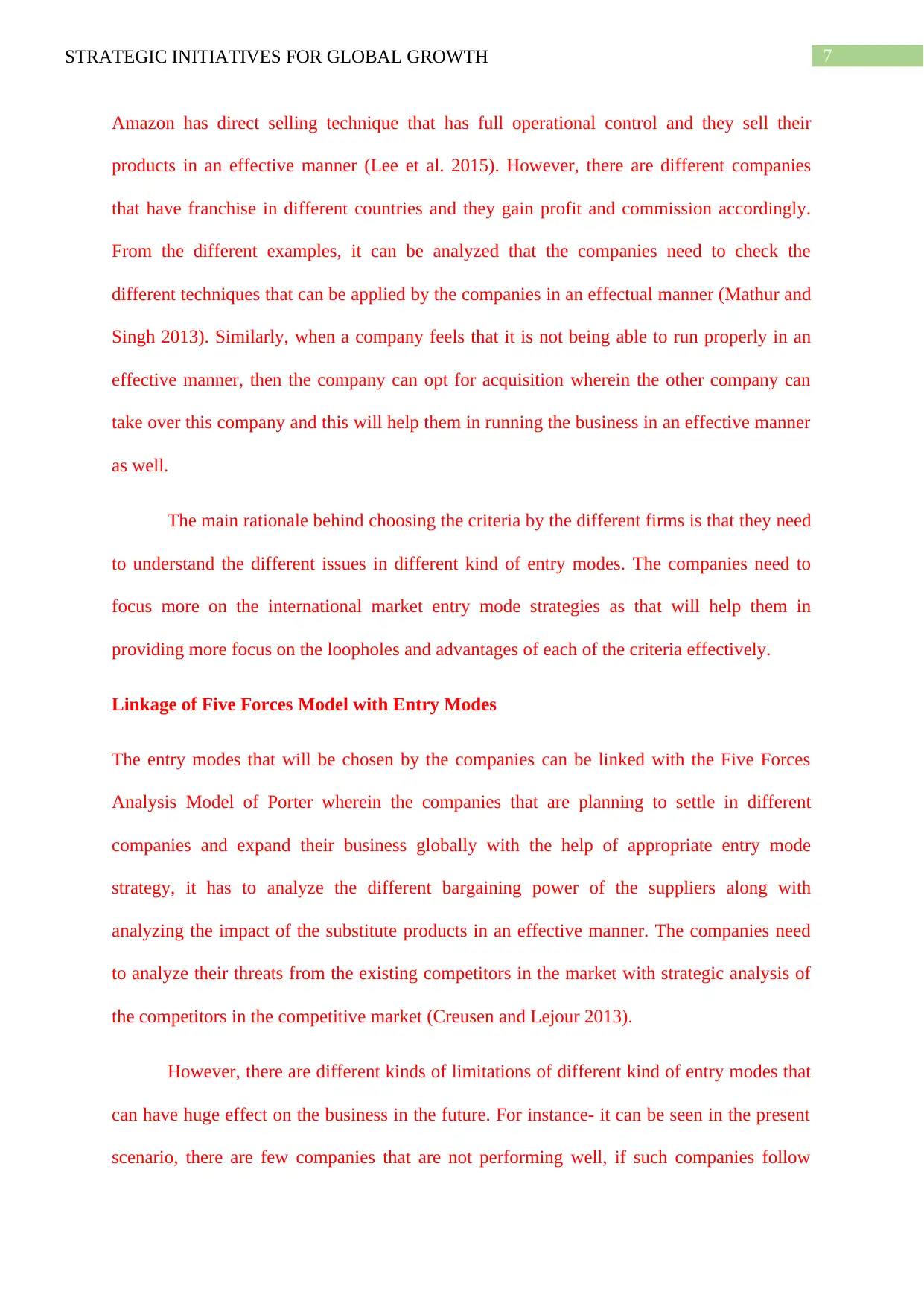
7STRATEGIC INITIATIVES FOR GLOBAL GROWTH
Amazon has direct selling technique that has full operational control and they sell their
products in an effective manner (Lee et al. 2015). However, there are different companies
that have franchise in different countries and they gain profit and commission accordingly.
From the different examples, it can be analyzed that the companies need to check the
different techniques that can be applied by the companies in an effectual manner (Mathur and
Singh 2013). Similarly, when a company feels that it is not being able to run properly in an
effective manner, then the company can opt for acquisition wherein the other company can
take over this company and this will help them in running the business in an effective manner
as well.
The main rationale behind choosing the criteria by the different firms is that they need
to understand the different issues in different kind of entry modes. The companies need to
focus more on the international market entry mode strategies as that will help them in
providing more focus on the loopholes and advantages of each of the criteria effectively.
Linkage of Five Forces Model with Entry Modes
The entry modes that will be chosen by the companies can be linked with the Five Forces
Analysis Model of Porter wherein the companies that are planning to settle in different
companies and expand their business globally with the help of appropriate entry mode
strategy, it has to analyze the different bargaining power of the suppliers along with
analyzing the impact of the substitute products in an effective manner. The companies need
to analyze their threats from the existing competitors in the market with strategic analysis of
the competitors in the competitive market (Creusen and Lejour 2013).
However, there are different kinds of limitations of different kind of entry modes that
can have huge effect on the business in the future. For instance- it can be seen in the present
scenario, there are few companies that are not performing well, if such companies follow
Amazon has direct selling technique that has full operational control and they sell their
products in an effective manner (Lee et al. 2015). However, there are different companies
that have franchise in different countries and they gain profit and commission accordingly.
From the different examples, it can be analyzed that the companies need to check the
different techniques that can be applied by the companies in an effectual manner (Mathur and
Singh 2013). Similarly, when a company feels that it is not being able to run properly in an
effective manner, then the company can opt for acquisition wherein the other company can
take over this company and this will help them in running the business in an effective manner
as well.
The main rationale behind choosing the criteria by the different firms is that they need
to understand the different issues in different kind of entry modes. The companies need to
focus more on the international market entry mode strategies as that will help them in
providing more focus on the loopholes and advantages of each of the criteria effectively.
Linkage of Five Forces Model with Entry Modes
The entry modes that will be chosen by the companies can be linked with the Five Forces
Analysis Model of Porter wherein the companies that are planning to settle in different
companies and expand their business globally with the help of appropriate entry mode
strategy, it has to analyze the different bargaining power of the suppliers along with
analyzing the impact of the substitute products in an effective manner. The companies need
to analyze their threats from the existing competitors in the market with strategic analysis of
the competitors in the competitive market (Creusen and Lejour 2013).
However, there are different kinds of limitations of different kind of entry modes that
can have huge effect on the business in the future. For instance- it can be seen in the present
scenario, there are few companies that are not performing well, if such companies follow
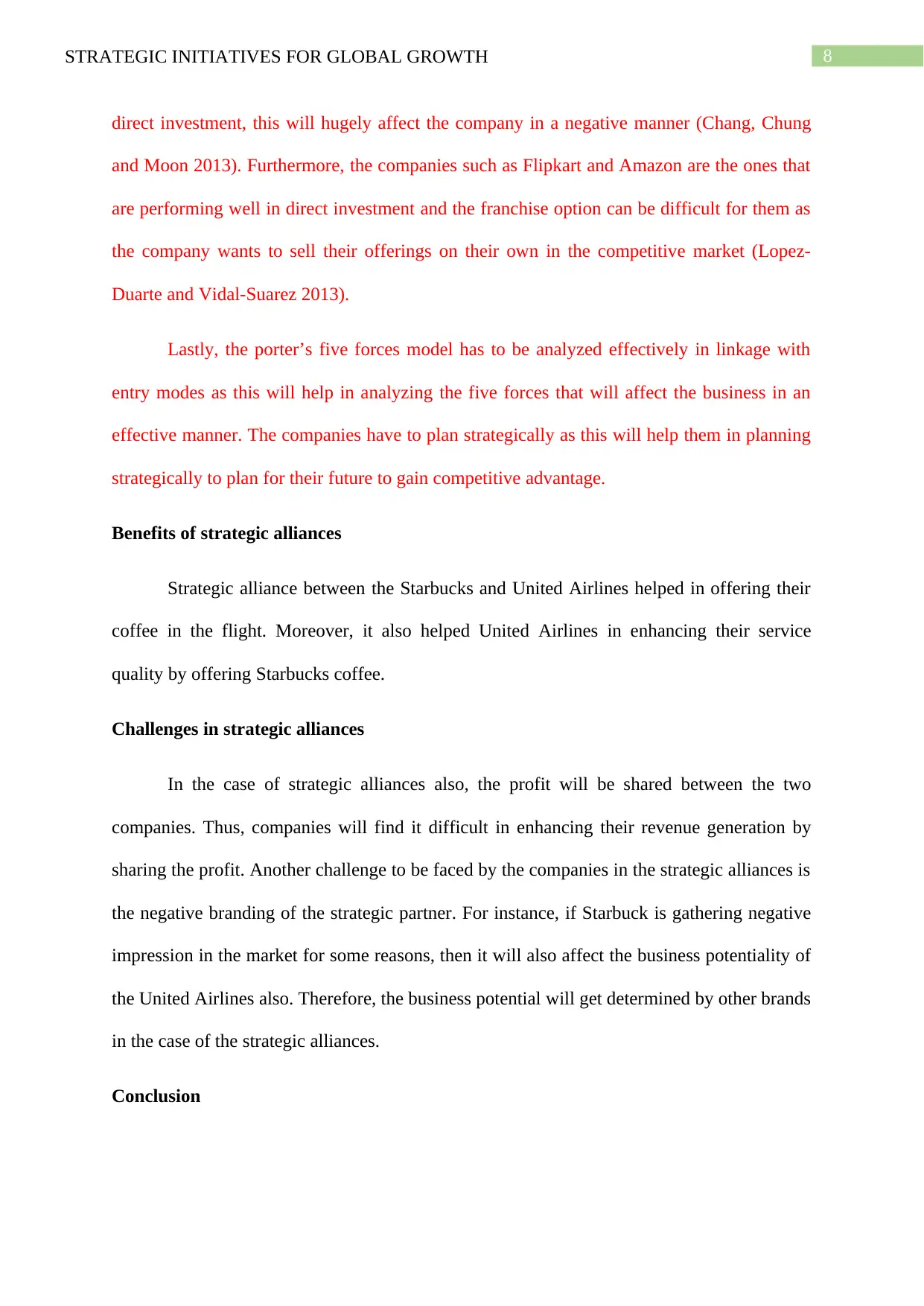
8STRATEGIC INITIATIVES FOR GLOBAL GROWTH
direct investment, this will hugely affect the company in a negative manner (Chang, Chung
and Moon 2013). Furthermore, the companies such as Flipkart and Amazon are the ones that
are performing well in direct investment and the franchise option can be difficult for them as
the company wants to sell their offerings on their own in the competitive market (Lopez-
Duarte and Vidal-Suarez 2013).
Lastly, the porter’s five forces model has to be analyzed effectively in linkage with
entry modes as this will help in analyzing the five forces that will affect the business in an
effective manner. The companies have to plan strategically as this will help them in planning
strategically to plan for their future to gain competitive advantage.
Benefits of strategic alliances
Strategic alliance between the Starbucks and United Airlines helped in offering their
coffee in the flight. Moreover, it also helped United Airlines in enhancing their service
quality by offering Starbucks coffee.
Challenges in strategic alliances
In the case of strategic alliances also, the profit will be shared between the two
companies. Thus, companies will find it difficult in enhancing their revenue generation by
sharing the profit. Another challenge to be faced by the companies in the strategic alliances is
the negative branding of the strategic partner. For instance, if Starbuck is gathering negative
impression in the market for some reasons, then it will also affect the business potentiality of
the United Airlines also. Therefore, the business potential will get determined by other brands
in the case of the strategic alliances.
Conclusion
direct investment, this will hugely affect the company in a negative manner (Chang, Chung
and Moon 2013). Furthermore, the companies such as Flipkart and Amazon are the ones that
are performing well in direct investment and the franchise option can be difficult for them as
the company wants to sell their offerings on their own in the competitive market (Lopez-
Duarte and Vidal-Suarez 2013).
Lastly, the porter’s five forces model has to be analyzed effectively in linkage with
entry modes as this will help in analyzing the five forces that will affect the business in an
effective manner. The companies have to plan strategically as this will help them in planning
strategically to plan for their future to gain competitive advantage.
Benefits of strategic alliances
Strategic alliance between the Starbucks and United Airlines helped in offering their
coffee in the flight. Moreover, it also helped United Airlines in enhancing their service
quality by offering Starbucks coffee.
Challenges in strategic alliances
In the case of strategic alliances also, the profit will be shared between the two
companies. Thus, companies will find it difficult in enhancing their revenue generation by
sharing the profit. Another challenge to be faced by the companies in the strategic alliances is
the negative branding of the strategic partner. For instance, if Starbuck is gathering negative
impression in the market for some reasons, then it will also affect the business potentiality of
the United Airlines also. Therefore, the business potential will get determined by other brands
in the case of the strategic alliances.
Conclusion
⊘ This is a preview!⊘
Do you want full access?
Subscribe today to unlock all pages.

Trusted by 1+ million students worldwide
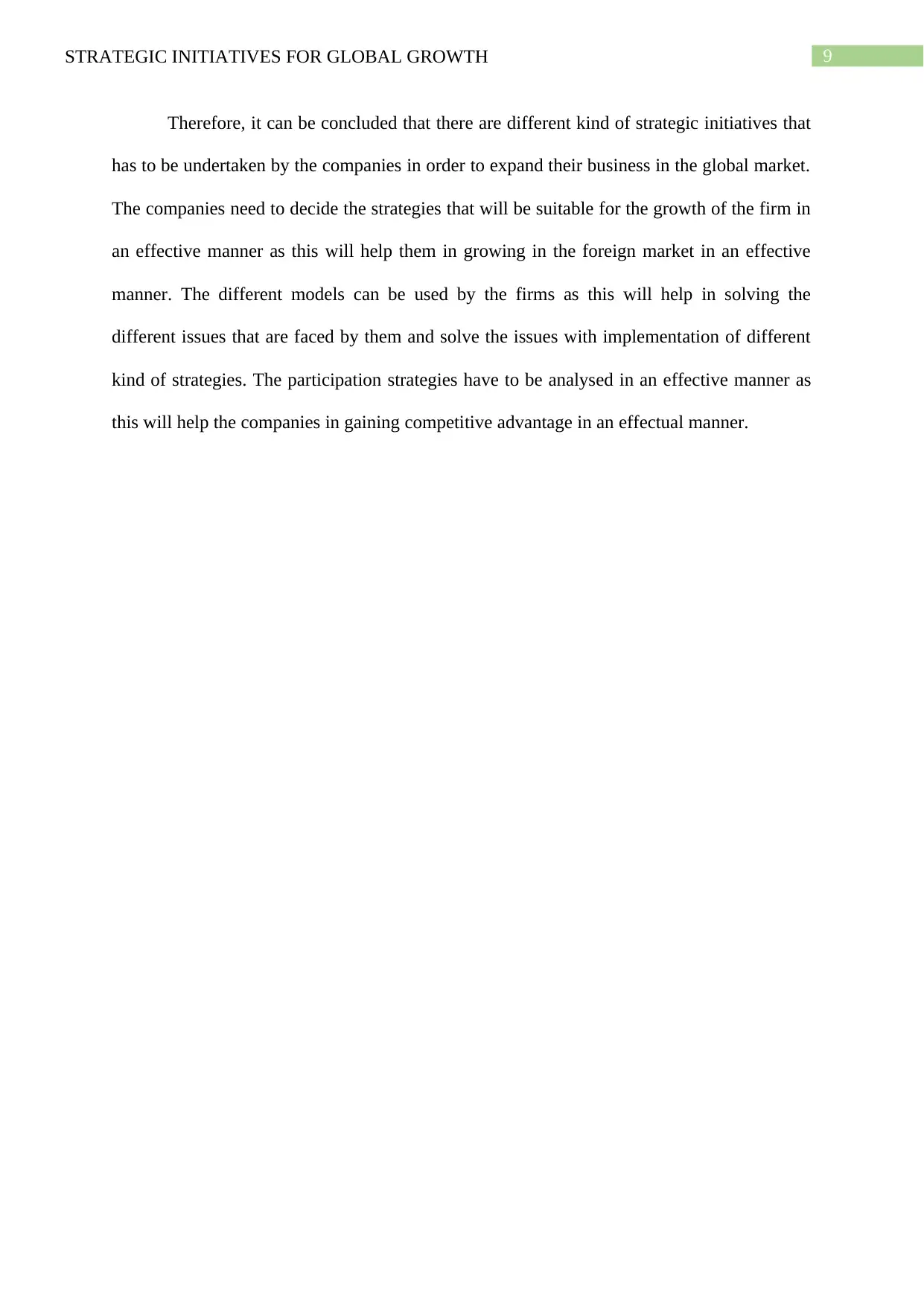
9STRATEGIC INITIATIVES FOR GLOBAL GROWTH
Therefore, it can be concluded that there are different kind of strategic initiatives that
has to be undertaken by the companies in order to expand their business in the global market.
The companies need to decide the strategies that will be suitable for the growth of the firm in
an effective manner as this will help them in growing in the foreign market in an effective
manner. The different models can be used by the firms as this will help in solving the
different issues that are faced by them and solve the issues with implementation of different
kind of strategies. The participation strategies have to be analysed in an effective manner as
this will help the companies in gaining competitive advantage in an effectual manner.
Therefore, it can be concluded that there are different kind of strategic initiatives that
has to be undertaken by the companies in order to expand their business in the global market.
The companies need to decide the strategies that will be suitable for the growth of the firm in
an effective manner as this will help them in growing in the foreign market in an effective
manner. The different models can be used by the firms as this will help in solving the
different issues that are faced by them and solve the issues with implementation of different
kind of strategies. The participation strategies have to be analysed in an effective manner as
this will help the companies in gaining competitive advantage in an effectual manner.
Paraphrase This Document
Need a fresh take? Get an instant paraphrase of this document with our AI Paraphraser
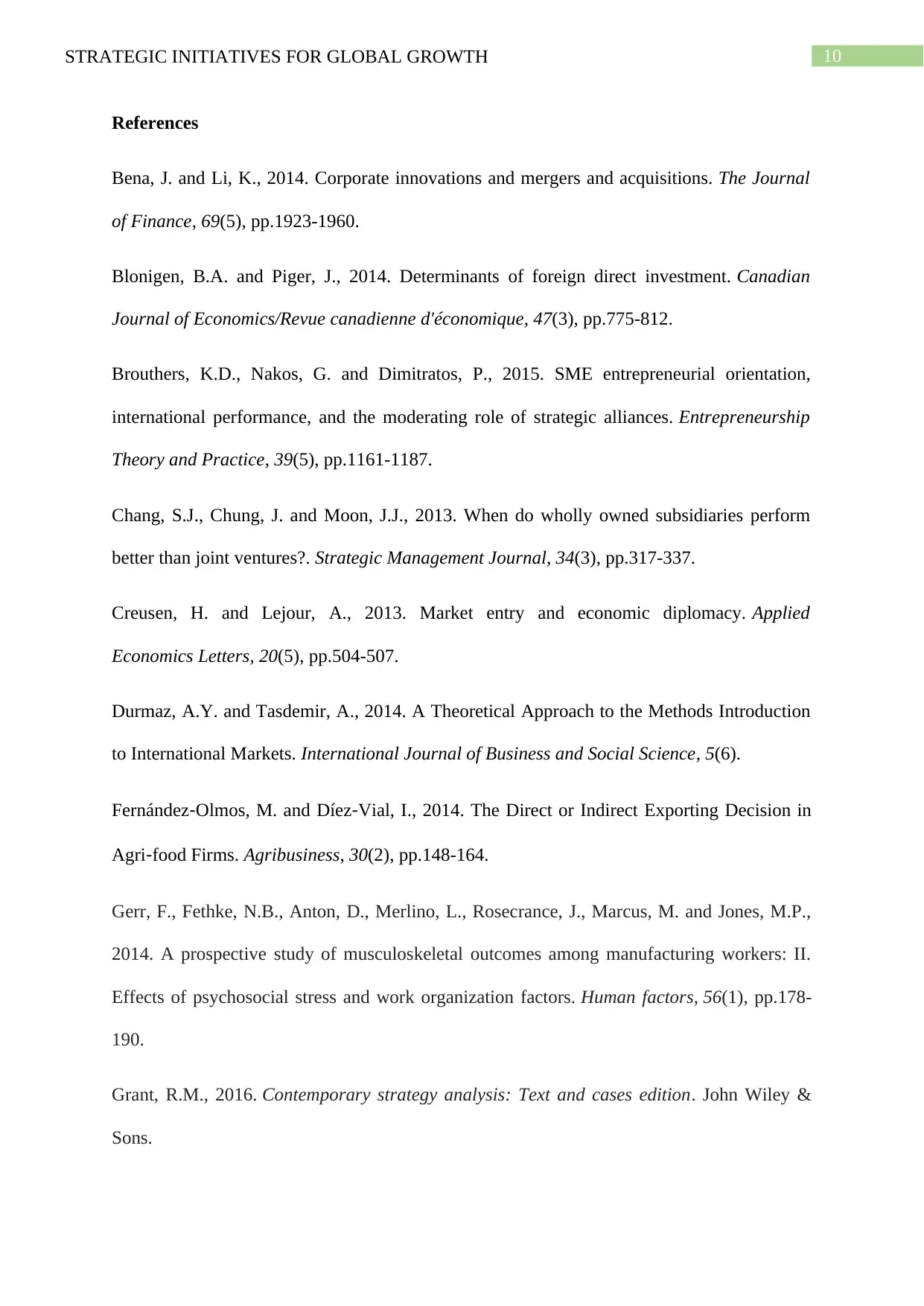
10STRATEGIC INITIATIVES FOR GLOBAL GROWTH
References
Bena, J. and Li, K., 2014. Corporate innovations and mergers and acquisitions. The Journal
of Finance, 69(5), pp.1923-1960.
Blonigen, B.A. and Piger, J., 2014. Determinants of foreign direct investment. Canadian
Journal of Economics/Revue canadienne d'économique, 47(3), pp.775-812.
Brouthers, K.D., Nakos, G. and Dimitratos, P., 2015. SME entrepreneurial orientation,
international performance, and the moderating role of strategic alliances. Entrepreneurship
Theory and Practice, 39(5), pp.1161-1187.
Chang, S.J., Chung, J. and Moon, J.J., 2013. When do wholly owned subsidiaries perform
better than joint ventures?. Strategic Management Journal, 34(3), pp.317-337.
Creusen, H. and Lejour, A., 2013. Market entry and economic diplomacy. Applied
Economics Letters, 20(5), pp.504-507.
Durmaz, A.Y. and Tasdemir, A., 2014. A Theoretical Approach to the Methods Introduction
to International Markets. International Journal of Business and Social Science, 5(6).
Fernández‐Olmos, M. and Díez‐Vial, I., 2014. The Direct or Indirect Exporting Decision in
Agri‐food Firms. Agribusiness, 30(2), pp.148-164.
Gerr, F., Fethke, N.B., Anton, D., Merlino, L., Rosecrance, J., Marcus, M. and Jones, M.P.,
2014. A prospective study of musculoskeletal outcomes among manufacturing workers: II.
Effects of psychosocial stress and work organization factors. Human factors, 56(1), pp.178-
190.
Grant, R.M., 2016. Contemporary strategy analysis: Text and cases edition. John Wiley &
Sons.
References
Bena, J. and Li, K., 2014. Corporate innovations and mergers and acquisitions. The Journal
of Finance, 69(5), pp.1923-1960.
Blonigen, B.A. and Piger, J., 2014. Determinants of foreign direct investment. Canadian
Journal of Economics/Revue canadienne d'économique, 47(3), pp.775-812.
Brouthers, K.D., Nakos, G. and Dimitratos, P., 2015. SME entrepreneurial orientation,
international performance, and the moderating role of strategic alliances. Entrepreneurship
Theory and Practice, 39(5), pp.1161-1187.
Chang, S.J., Chung, J. and Moon, J.J., 2013. When do wholly owned subsidiaries perform
better than joint ventures?. Strategic Management Journal, 34(3), pp.317-337.
Creusen, H. and Lejour, A., 2013. Market entry and economic diplomacy. Applied
Economics Letters, 20(5), pp.504-507.
Durmaz, A.Y. and Tasdemir, A., 2014. A Theoretical Approach to the Methods Introduction
to International Markets. International Journal of Business and Social Science, 5(6).
Fernández‐Olmos, M. and Díez‐Vial, I., 2014. The Direct or Indirect Exporting Decision in
Agri‐food Firms. Agribusiness, 30(2), pp.148-164.
Gerr, F., Fethke, N.B., Anton, D., Merlino, L., Rosecrance, J., Marcus, M. and Jones, M.P.,
2014. A prospective study of musculoskeletal outcomes among manufacturing workers: II.
Effects of psychosocial stress and work organization factors. Human factors, 56(1), pp.178-
190.
Grant, R.M., 2016. Contemporary strategy analysis: Text and cases edition. John Wiley &
Sons.
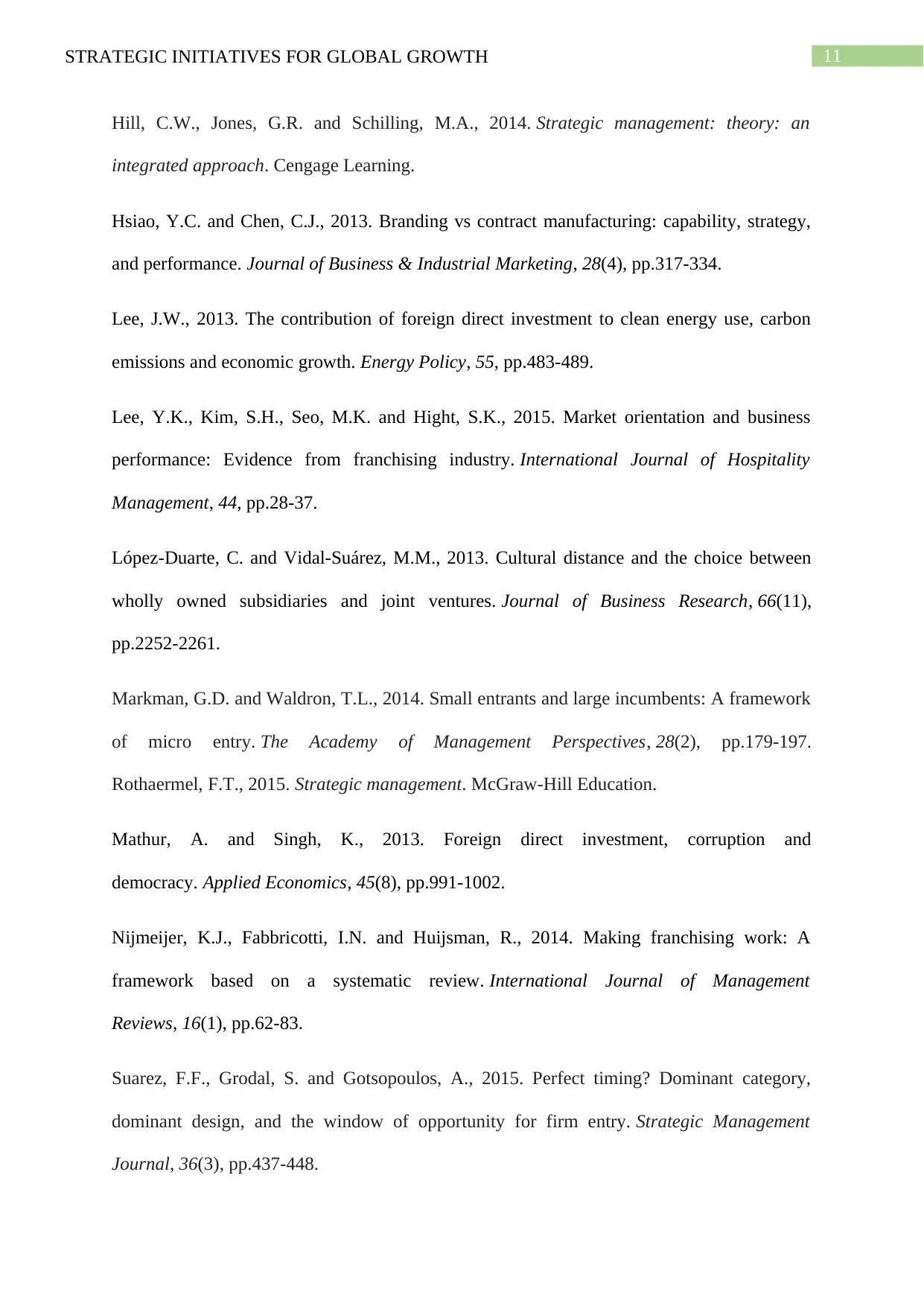
11STRATEGIC INITIATIVES FOR GLOBAL GROWTH
Hill, C.W., Jones, G.R. and Schilling, M.A., 2014. Strategic management: theory: an
integrated approach. Cengage Learning.
Hsiao, Y.C. and Chen, C.J., 2013. Branding vs contract manufacturing: capability, strategy,
and performance. Journal of Business & Industrial Marketing, 28(4), pp.317-334.
Lee, J.W., 2013. The contribution of foreign direct investment to clean energy use, carbon
emissions and economic growth. Energy Policy, 55, pp.483-489.
Lee, Y.K., Kim, S.H., Seo, M.K. and Hight, S.K., 2015. Market orientation and business
performance: Evidence from franchising industry. International Journal of Hospitality
Management, 44, pp.28-37.
López-Duarte, C. and Vidal-Suárez, M.M., 2013. Cultural distance and the choice between
wholly owned subsidiaries and joint ventures. Journal of Business Research, 66(11),
pp.2252-2261.
Markman, G.D. and Waldron, T.L., 2014. Small entrants and large incumbents: A framework
of micro entry. The Academy of Management Perspectives, 28(2), pp.179-197.
Rothaermel, F.T., 2015. Strategic management. McGraw-Hill Education.
Mathur, A. and Singh, K., 2013. Foreign direct investment, corruption and
democracy. Applied Economics, 45(8), pp.991-1002.
Nijmeijer, K.J., Fabbricotti, I.N. and Huijsman, R., 2014. Making franchising work: A
framework based on a systematic review. International Journal of Management
Reviews, 16(1), pp.62-83.
Suarez, F.F., Grodal, S. and Gotsopoulos, A., 2015. Perfect timing? Dominant category,
dominant design, and the window of opportunity for firm entry. Strategic Management
Journal, 36(3), pp.437-448.
Hill, C.W., Jones, G.R. and Schilling, M.A., 2014. Strategic management: theory: an
integrated approach. Cengage Learning.
Hsiao, Y.C. and Chen, C.J., 2013. Branding vs contract manufacturing: capability, strategy,
and performance. Journal of Business & Industrial Marketing, 28(4), pp.317-334.
Lee, J.W., 2013. The contribution of foreign direct investment to clean energy use, carbon
emissions and economic growth. Energy Policy, 55, pp.483-489.
Lee, Y.K., Kim, S.H., Seo, M.K. and Hight, S.K., 2015. Market orientation and business
performance: Evidence from franchising industry. International Journal of Hospitality
Management, 44, pp.28-37.
López-Duarte, C. and Vidal-Suárez, M.M., 2013. Cultural distance and the choice between
wholly owned subsidiaries and joint ventures. Journal of Business Research, 66(11),
pp.2252-2261.
Markman, G.D. and Waldron, T.L., 2014. Small entrants and large incumbents: A framework
of micro entry. The Academy of Management Perspectives, 28(2), pp.179-197.
Rothaermel, F.T., 2015. Strategic management. McGraw-Hill Education.
Mathur, A. and Singh, K., 2013. Foreign direct investment, corruption and
democracy. Applied Economics, 45(8), pp.991-1002.
Nijmeijer, K.J., Fabbricotti, I.N. and Huijsman, R., 2014. Making franchising work: A
framework based on a systematic review. International Journal of Management
Reviews, 16(1), pp.62-83.
Suarez, F.F., Grodal, S. and Gotsopoulos, A., 2015. Perfect timing? Dominant category,
dominant design, and the window of opportunity for firm entry. Strategic Management
Journal, 36(3), pp.437-448.
⊘ This is a preview!⊘
Do you want full access?
Subscribe today to unlock all pages.

Trusted by 1+ million students worldwide
1 out of 13
Related Documents
Your All-in-One AI-Powered Toolkit for Academic Success.
+13062052269
info@desklib.com
Available 24*7 on WhatsApp / Email
![[object Object]](/_next/static/media/star-bottom.7253800d.svg)
Unlock your academic potential
Copyright © 2020–2025 A2Z Services. All Rights Reserved. Developed and managed by ZUCOL.





